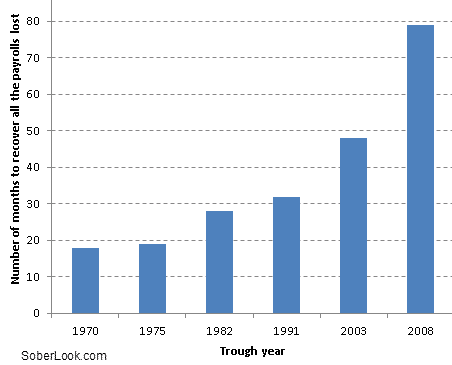The pattern of increasingly longer payrolls recoveries
By Sober Look
Continuing with the recent theme of the US labor markets, consider the chart below. It’s the total US employees on nonfarm payrolls going back to the mid 60s. We’ve heard numerous discussions about how the current payrolls correction is far deeper and will take much longer to recover than in previous recessions. But there is a pattern in this chart.

Here is a simple exercise. Let’s select all the troughs in the payroll chart and see how long it takes from that point to recover all the jobs lost from the previous peak (ignoring the 1980 blip for this analysis – the real correction took place the following year). For the 2008 trough, let’s assume that we continue to create jobs at the average rate of the last six months (March – Aug). Yes, it could be wishful thinking, but 97K (which is roughly what we got for August) per month feels fairly realistic. And now we can see a pattern emerging.

Why did each consecutive decline in payrolls take longer to recover (in a nearly exponential fashion)? The answer may have to do with the historic shift out of manufacturing jobs, increasing dependence on financing and bank lending in order to generate new jobs, inability of services industries to recover quickly, increasingly larger “bubbles” in the economy, etc. Whatever the case, the question remains: what will the next payrolls downturn look like? Let’s hope this pattern does not persist going forward.
I suspect that the pattern will carry on in future, The nature of job creation is dependant on small businesses and this crisis has hit them harder because banks have curtailed lending. Even within the UK where there are lending targets for businesses the money is lent to those that do not need the money, and small businesses are offered loans at higher rates than normal. It is harder than ever for small businesses to get adequate capital because of the high costs of business assets held artificially high by QE and other central bank policies.